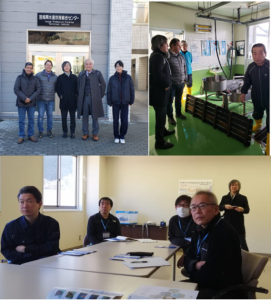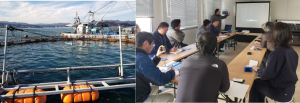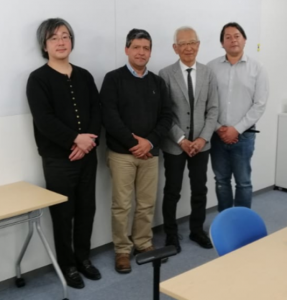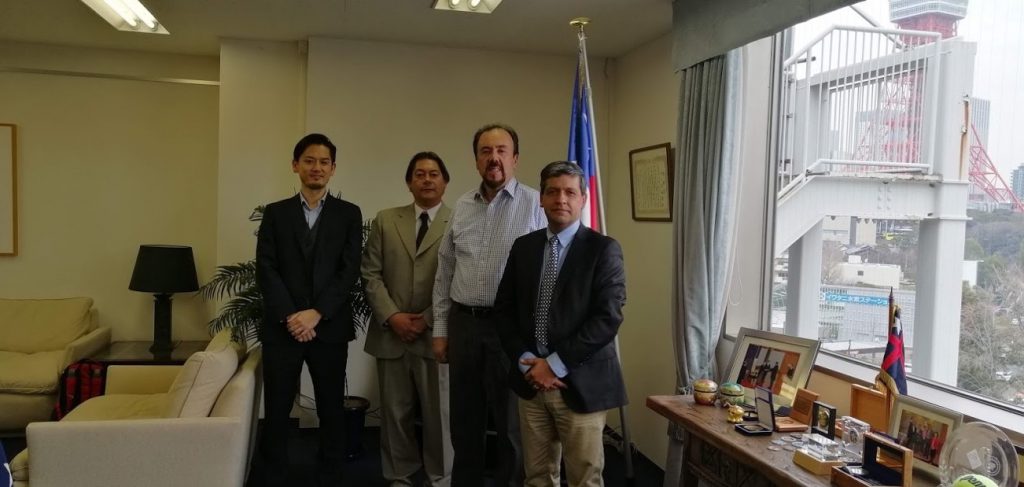The ecosystem anomalies observed in Chilean coastal waters in recent years, especially outbreaks or harmful algae bloom (HAB). The HAB are currently a threat to the Chilean aquaculture industry, as well as to the marine ecosystem of a larger area. Episodes of large-scale fish mortality caused by HAB occurred in the Los Lagos region during March and May 2016, where the accumulation of paralyzing toxin in filtered seafood from natural and farmed shallows caused by a HAB was almost observed, damaging both to artisanal fishing and aquaculture, generating public health alert. In this way, it is urgent to carry out detailed investigations to counteract these damages, particularly those related to environmental microbiology.
This Chile-Japan binational cooperation project seeks to characterize the dynamics of the HAB in Chilean coastal waters from the environmental microbiological point of view: we propose to understand the HAB as a holobiome (holo = complete, biome = ecosystem), specifically focusing on the characterization of Biological interactions between the constituent microbial species, to elucidate the dynamics of these outbreaks.
In this context, SATREPS MACH has invited through this MACH project, the General Manager of INTESAL, Mgtr., Esteban Ramirez and the Head of Projects of INTEMIT, Dr. Cristian Segura to participate in a technological tour to Japan, where they were received and guided permanently by Prof. Fumito Maruyama (Hiroshima University) and Emeritus prof. Ichiro Imai (Hokkaido University). The technological tour was carried out between February 9 and 14, 2020, where the following visits to public and private entities were included:
1.AOMORI FISHERIES RESEARCH INSTITUTE.
Where aspects associated with oyster crops grown in Japan were reviewed vs mussels grown in southern Chile, focusing on the toxic effects of HAB and control measures implemented by governments. We have talked about HAB, the effects on shellfish and salmon, considering oceanographic monitoring programs.
Learning: good and rational monitoring is key to making correct decisions. Chile is developing a new regulation that will force salmon producers to monitor the ocean using buoys. INTEMIT have been able to centralize the environmental information of the Bivalve Mollusc Health Program in BIBLIOMIT (www.bibliomit.cl), while INTESAL has developed its environmental platform through PROMOFI (http://mapas.intesal.cl/publico/).

2.TOHOKU FISHERIES RESEARCH INSTITUTE AND MIYAGI FISHERIES RESEARCH INSTITUTE
Aspects of productive strategies associated with oyster aquaculture and shellfish poisoning were known. The effects of the tsunami and temperature on production and how it is possible that the movement of the sediment generates some environmental change that activates the Alexandrium catenella blooms from the resistance cysts. We visited to Tohoku Fisheries Research Institute and Miyagi Fisheries Research Institute to learn about and Japanese Oyster and silver salmon farming as well as fish diseases.
Learning: The HAB are affected by different environmental conditions, such as water temperature, salinity, and concentration of nutrients and the daylight hours. In addition to these physicochemical factors, recent research indicates the existence of biological factors that can affect the HAB dynamics.

3.VISIT SALMON AND OYSTER FARM
The differences in the productive strategies used in the salmon industries of Japan and Chile were discussed. The system for growing mussels was reviewed in detail to compare with oysters and thus, to look for opportunities for technological developments to minimize HAB risks (e.g., submerged culture systems).
Learning: The idea arises to submerge the lines of mussels in case of algae on the surface. In the case of salmon farming, in Japan they have not detected problems with the seabed, given a production with very short cycles (Coho production), which limit its volume, leaving several months per year for organic matter to be assimilated naturally, this makes it possible for the feeding system, for example, to be still practically manual, without underwater control by cameras or other elements other than just observing from the surface the activity of the fish.

4. VISIT TO JAPAN FISHERIES SCIENCE AND TECHNOLOGY ASSOCIATION
We met Dr. Takeshi Hara. A great conversation was held on salmon farming and shellfish farming in Chile, raising the multiple challenges associated with the production phases, environmental restrictions, regulations, communities and HAB.
Learning: In Chile we have concentrated on monitoring and following up on HAB in its early stages of dispersal as microalgae in the water column and in their late toxicological state, in the meat of hydro-biological products, however there are no measures that aim to develop HAB prevention or mitigation actions.

5. MEETIN WITH DR. ICHIRO IMAI
We had had a lot of discussion with Emeritus prof. Imai about how to prevent HAB and how the MACH project could help in that direction. The following ideas are highlighted from this meeting for future development.
- Some bacteria that could reduce some specific HAB. We believe that some results of the MACH project could help to understand the dynamics of the marine microbiota, depending on the responses of the HAB.
- Diatoms compete with dinoflagellates (e.g. A. catenella), which could help us prevent and/or mitigate HAB.

6.MEETING WITH MITSUI & CO., LTD.
The MITSUI & CO., LTD.co-finances the MATCH project and the visit was created to share the progress of ongoing SATREPS project and exchange direct opinions between Mitsui and Chilean aquaculture industries members of salmon and mussel regarding to the importance of project and HAB related social issues in Chile.

7. MEETING WITH CHILEAN EMBASSY IN JAPAN
The Chilean delegation met with the Chilean Ambassador to Japan, Mr. Julio Fiol, with whom we had an interesting conversation about the challenges of the salmon and mussel aquaculture industries in terms of opportunities to establish new markets, as well as potential internal consumption of seafood. The ambassador and his team illustrated the importance and appreciation of the Japanese towards the all sea resources.

8. MEETING WITH JICA / JST
At the end of technological tour, the Chilean aquaculture delegation met with the Japanese International Cooperation Agency (JICA) and Japan Science and Technology Agency (JST), entities that promotes and finances the MACH Project. At this meeting, the Chilean delegation discussed, on the opportunities to incorporate into the regular monitoring and analysis of marine toxins carried out by the salmon and mussel industries in Chile, the ability to prevent and mitigate HAB through collaborative project initiatives.
